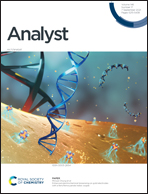A three-dimensional hydrogel-modified indium tin oxide electrode with enhanced performance for in situ electrochemical detection of extracellular H2O2†
Abstract
Two different electrochemical sensors (Hemin-G4/Au/GCE and Hemin-G4/Au/ITO) were developed and applied to explore the electrocatalytic capacity of H2O2 reduction. Due to the excellent catalytic activity of Hemin-G4 and high conductivity of gold nanoparticles, both electrodes show excellent electrochemical performances towards H2O2 with a low LOD (0.67 μM for Hemin-G4/Au/GCE and 0.65 μM for Hemin-G4/Au/ITO), rapid response (<4 s), and high selectivity and sensitivity (314.33 μA mM−1 cm−2 for Hemin-G4/Au/GCE and 322.22 μA mM−1 cm−2 for Hemin-G4/Au/ITO). The two electrodes allow sensitive capture of H2O2 produced by A549 cells. Compared with the conventional method of detection in cell suspensions, an ITO electrode with a large specific surface area and good biocompatibility can provide a promising platform for cell adhesion, so as to realize real-time and in situ detection of extracellular H2O2. The experimental results show that A549 cells can adhere to the surface of the Hemin-G4/Au/ITO electrode and grow well. This is benefitted from the three-dimensional structure of the Hemin-G4/Au hydrogel, which provides a suitable microenvironment for cell adhesion and growth. Furthermore, the in situ detection shows a faster response time than that of in-solution detection. This is because the H2O2 generated by the cells can be directly captured by the ITO electrode, which avoids diffusion from the solution to the electrode. These results indicate that the self-supporting hydrogel modified ITO electrode has great application prospects in basic biomedical research and continuous dynamic surveillance of diseases.



 Please wait while we load your content...
Please wait while we load your content...